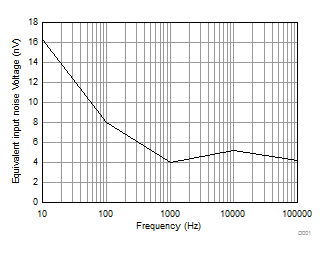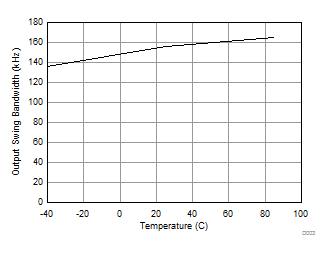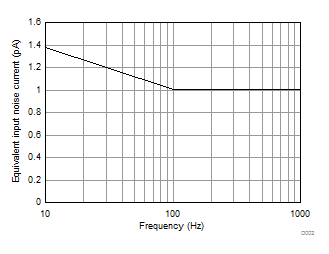SLOS075J November 1979 – January 2015 NE5532 , NE5532A , SA5532 , SA5532A
PRODUCTION DATA.
- 1 Features
- 2 Applications
- 3 Description
- 4 Simplified Schematic
- 5 Revision History
- 6 Pin Configuration and Functions
- 7 Specifications
- 8 Detailed Description
- 9 Application and Implementation
- 10Power Supply Recommendations
- 11Layout
- 12Device and Documentation Support
- 13Mechanical, Packaging, and Orderable Information
パッケージ・オプション
メカニカル・データ(パッケージ|ピン)
サーマルパッド・メカニカル・データ
発注情報
7 Specifications
7.1 Absolute Maximum Ratings
over operating free-air temperature range (unless otherwise noted)(1)| MIN | MAX | UNIT | |||
|---|---|---|---|---|---|
| VCC | Supply voltage(2) | VCC+ | 0 | 22 | V |
| VCC– | –22 | 0 | V | ||
| Input voltage, either input(2)(3) | VCC– | VCC+ | V | ||
| Input current(4) | –10 | 10 | mA | ||
| Duration of output short circuit(5) | Unlimited | ||||
| TJ | Operating virtual-junction temperature | 150 | °C | ||
| Tstg | Storage temperature range | –65 | 150 | °C | |
(1) Stresses beyond those listed under Absolute Maximum Ratings may cause permanent damage to the device. These are stress ratings only, and functional operation of the device at these or any other conditions beyond those indicated under Recommended Operating Conditions is not implied. Exposure to absolute-maximum-rated conditions for extended periods may affect device reliability.
(2) All voltage values, except differential voltages, are with respect to the midpoint between VCC+ and VCC–.
(3) The magnitude of the input voltage must never exceed the magnitude of the supply voltage.
(4) Excessive input current will flow if a differential input voltage in excess of approximately 0.6 V is applied between the inputs, unless some limiting resistance is used.
(5) The output may be shorted to ground or either power supply. Temperature and/or supply voltages must be limited to ensure the maximum dissipation rating is not exceeded.
7.2 ESD Ratings
| VALUE | UNIT | ||||
|---|---|---|---|---|---|
| V(ESD) | Electrostatic discharge | Human body model (HBM), per ANSI/ESDA/JEDEC JS-001, all pins(1) | 2000 | V | |
| Charged device model (CDM), per JEDEC specification JESD22-C101, all pins(2) | 1000 | ||||
(1) JEDEC document JEP155 states that 500-V HBM allows safe manufacturing with a standard ESD control process.
(2) JEDEC document JEP157 states that 250-V CDM allows safe manufacturing with a standard ESD control process.
7.3 Recommended Operating Conditions
| MIN | MAX | UNIT | |||
|---|---|---|---|---|---|
| VCC+ | Supply voltage | 5 | 15 | V | |
| VCC– | Supply voltage | –5 | –15 | V | |
| TA | Operating free-air temperature | NE5532, NE5532A | 0 | 70 | °C |
| SA5532, SA5532A | –40 | 85 | |||
7.4 Thermal Information
| THERMAL METRIC(1) | NE5532, NE5532A, SA5532, and SA5532A | UNIT | |||
|---|---|---|---|---|---|
| D | P | PS | |||
| 8 PINS | |||||
| RθJA | Junction-to-ambient thermal resistance (3)(2) | 97 | 85 | 95 | °C/W |
(1) For more information about traditional and new thermal metrics, see the IC Package Thermal Metrics application report, SPRA953.
(2) Maximum power dissipation is a function of TJ(max), θJA, and TA. The maximum allowable power dissipation at any allowable ambient temperature is PD = (TJ(max) – TA) / θJA. Operating at the absolute maximum TJ of 150°C can affect reliability.
(3) The package thermal impedance is calculated in accordance with JESD 51-7.
7.5 Electrical Characteristics
VCC± = ±15 V, TA = 25°C (unless otherwise noted)| PARAMETER | TEST CONDITIONS(1) | MIN | TYP | MAX | UNIT | ||
|---|---|---|---|---|---|---|---|
| VIO | Input offset voltage | VO = 0 | TA = 25°C | 0.5 | 4 | mV | |
| TA = Full range(2) | 5 | ||||||
| IIO | Input offset current | TA = 25°C | 10 | 150 | nA | ||
| TA = Full range(2) | 200 | ||||||
| IIB | Input bias current | TA = 25°C | 200 | 800 | nA | ||
| TA = Full range(2) | 1000 | ||||||
| VICR | Common-mode input-voltage range | ±12 | ±13 | V | |||
| VOPP | Maximum peak-to-peak output-voltage swing | RL ≥ 600 Ω, VCC± = ±15 V | 24 | 26 | V | ||
| AVD | Large-signal differential-voltage amplification | RL ≥ 600 Ω, VO = ±10 V | TA = 25°C | 15 | 50 | V/mV | |
| TA = Full range(2) | 10 | ||||||
| RL ≥ 2 kΩ, VO±10 V | TA = 25°C | 25 | 100 | ||||
| TA = Full range(2) | 15 | ||||||
| Avd | Small-signal differential-voltage amplification | f = 10 kHz | 2.2 | V/mV | |||
| BOM | Maximum output-swing bandwidth | RL = 600 Ω, VO = ±10 V | 140 | kHz | |||
| B1 | Unity-gain bandwidth | RL = 600 Ω, CL = 100 pF | 10 | MHz | |||
| ri | Input resistance | 30 | 300 | kΩ | |||
| zo | Output impedance | AVD = 30 dB, RL = 600 Ω, f = 10 kHz | 0.3 | Ω | |||
| CMRR | Common-mode rejection ratio | VIC = VICR min | 70 | 100 | dB | ||
| kSVR | Supply-voltage rejection ratio (ΔVCC±/ΔVIO) | VCC± = ±9 V to ±15 V, VO = 0 | 80 | 100 | dB | ||
| IOS | Output short-circuit current | 10 | 38 | 60 | mA | ||
| ICC | Total supply current | VO = 0, No load | 8 | 16 | mA | ||
| Crosstalk attenuation (VO1/VO2) | V01 = 10 V peak, f = 1 kHz | 110 | dB | ||||
(1) All characteristics are measured under open-loop conditions, with zero common-mode input voltage, unless otherwise specified.
(2) Full temperature ranges are: –40°C to 85°C for the SA5532 and SA5532A devices, and 0°C to 70°C for the NE5532 and NE5532A devices.
7.6 Operating Characteristics
VCC± = ±15 V, TA = 25°C (unless otherwise noted)| PARAMETER | TEST CONDITIONS | NE5532, SA5532 | NE5532A, SA5532A | UNIT | |||||
|---|---|---|---|---|---|---|---|---|---|
| MIN | TYP | MAX | MIN | TYP | MAX | ||||
| SR | Slew rate at unity gain | 9 | 9 | V/μs | |||||
| Overshoot factor | VI = 100 mV, RL = 600 Ω, AVD = 1, CL = 100 pF |
10 | 10 | % | |||||
| Vn | Equivalent input noise voltage | f = 30 Hz | 8 | 8 | 10 | nV/√Hz | |||
| f = 1 kHz | 5 | 5 | 6 | ||||||
| In | Equivalent input noise current | f = 30 Hz | 2.7 | 2.7 | pA/√Hz | ||||
| f = 1 kHz | 0.7 | 0.7 | |||||||
7.7 Typical Characteristics
 Figure 1. Equivalent Input Noise Voltage vs Frequency
Figure 1. Equivalent Input Noise Voltage vs Frequency
 Figure 3. Output Swing Bandwidth
Figure 3. Output Swing Bandwidthvs Temperature at VCC = ±10 V
 Figure 2. Equivalent Input Noise Current vs Frequency
Figure 2. Equivalent Input Noise Current vs Frequency